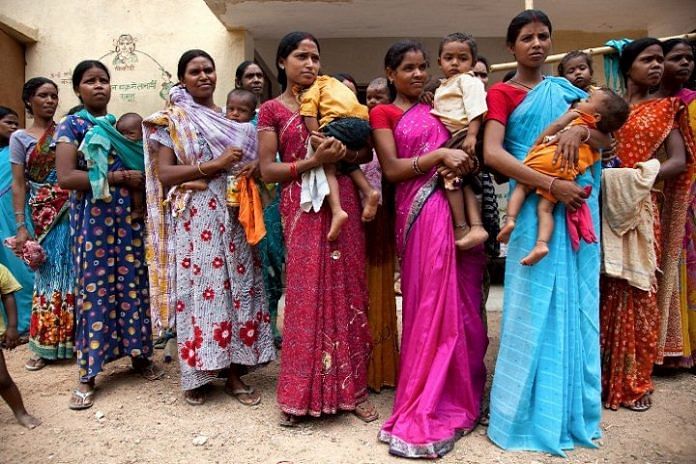According to data released by the registrar general of India, Kerala registered the lowest maternal mortality ratio in 2014-16, at 46, emerging as one of the few states with a double-digit figure.
New Delhi: Indian mothers are a lot safer now than they were three years ago, but a long way still from their peers in the developed world.
According to data released by the registrar general of India, the authority on all census matters, India’s maternal mortality ratio (MMR) has fallen to 130 in 2014-2016 from 167 in 2011-2013, a drop of 22 per cent.
MMR, among the crucial indicators of a country’s health, signifies the number of mothers dying per one lakh live births due to complications from pregnancy or childbirth. The data for India has been compiled from the sample registration system (SRS), the country’s birth and death database.
“It is a big achievement for our health sector,” said union health and family welfare minister J.P. Nadda about the results Monday. “The latest SRS figures reveal that we have gone beyond the MDG target of MMR of 139 by 2015.”
MDG, or millennium development goals, was a UN programme launched in 2000 that committed signatory nations to follow an eight-point programme to combat problems such as poverty and disease by 2015. Under it, India was to bring down its MMR from 556 in 1990 to 139 by 2015.
The best performers
According to the SRS data, Kerala registered the lowest MMR in 2014-16, 46, emerging as one of the few states with a double-digit figure. With an MMR of 61, Maharashtra was second, and Tamil Nadu third with 66 maternal deaths for every one lakh births.
With an MMR nearly double the national average, 237, Assam fared the worst. On a brighter note, the figure signifies a fall of 21 per cent since 2011-13, when the figure stood at 300.
The fall has been the sharpest in Uttar Pradesh/Uttarakhand — 29.5 per cent, from 285 in 2011-13 to 201 in 2014-16.
“Strategic changes have had an impact in getting these encouraging results,” said Nadda.
“Lifestyle changes like reducing teenage pregnancies, (and offering) ante-natal and post-natal care has helped in reducing maternal deaths. In the past one year, 1.25 crore checkups were carried out and 6.5 lakh high-risk patients identified…” he added, “Convergence by health workers, anganwadis… prevented the deaths.”
There been a massive government push in recent years to improve the health infrastructure for new mothers and newborns, with a study published in The Lancet in 2016 claiming that as many as 15 per cent of the world’s total maternal deaths took place in India.
The government claims to have immunised more than 80 lakh pregnant women under Mission Indradhanush, aimed at complete vaccination of newborns, while a cash incentive of Rs 6,000 is given out under the Pradhan Mantri Matru Vandana Yojana to encourage pregnant and lactating mothers to take rest and go for timely checkups.
Under the Pradhan Mantri Surakshit Matritva Abhiyan, more than 1.16 crore ante-natal checkups have been conducted at over 12,900 health facilities since its launch in November 2016.
‘Long way to go’
India’s strides vis-à-vis MMR have been praised by the UNICEF.
“India has shown impressive progress in reducing maternal deaths, with nearly 1,000 fewer women now dying of pregnancy-related complications each month in India as compared to 2013,” the UNICEF representative in India, Dr Yasmin A. Haque, said.
Experts in women’s health said the falling figure spelt a “sigh of relief”, but added that more needs to be done.
Dr Rekha Daver, head of medical education and consultant dealing with obstetrics and gynaecology at Mumbai’s Sir H.N. Reliance Hospital, credited government initiatives like the Janani Shishu Suraksha Karyakram (JSSK) for the success. Aimed at encouraging more women to opt for an institutional delivery, the scheme offers new mothers and their infants free hospital care.
“It is a new beginning but we have to go far ahead,” she told ThePrint, “We have to educate more women and make them aware about caring for their health.”
She added that the situation was improving at the rural level too. “The National Health Scheme has been a help… I would credit ASHA (accredited social health activists) workers, who conduct home visits to create awareness among family members and patients to encourage them to seek timely treatment,” she said.
Far behind the developed world
According to doctors, the main reason behind the morbid mortality scenario is the weak health of girls across the country, with gynaecologists pinning haemorrhage during childbirth and lack of blood banks as the main cause of maternal mortality. In this situation, they say, ante-natal checkups prove crucial.
“What ante-natal screening does is, it detects the levels of blood, iron or the anaemic status of a woman very early. During pregnancy, the foetus uses a mother’s iron stores, and thus the mother tends to become anaemic, and at the time of pregnancy blood loss can be absolutely fatal,” said Dr Ranjana Sharma, who practises obstetrics and gynaecology at Apollo Hospital.
“The move of the government is in the right direction but we have a long way to go. We are doing our bit but are still far behind developed countries,” she said. “We have to impart more education in rural sectors. Early marriages are still an issue, which makes women more vulnerable.”
India’s MMR is now way below the global average, recorded at 216 in 2015, according to UN inter-agency estimates. However, it still towers over those seen in the developed world, with Greece, Finland, Iceland and Poland recording all of three maternal deaths for every one lakh births as of 2015. The figure is 14 for the US, which is said to have the worst MMR in the developed world.






